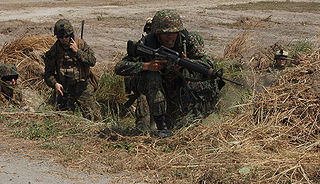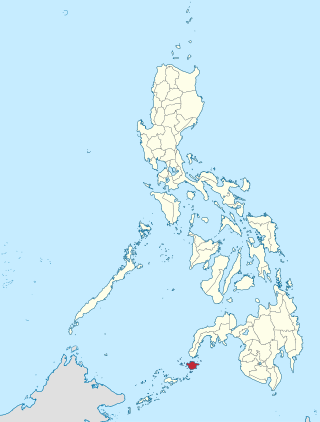
Abu Sayyaf, officially known by the Islamic State as the Islamic State – East Asia Province, is a Jihadist militant and pirate group that follows the Wahhabi doctrine of Sunni Islam. It is based in and around Jolo and Basilan islands in the southwestern part of the Philippines, where for more than four decades, Moro groups have been engaged in an insurgency seeking to make Moro Province independent. The group is considered violent and was responsible for the Philippines' worst terrorist attack, the bombing of MV Superferry 14 in 2004, which killed 116 people. The name of the group is derived from the Arabic abu ; "father of"), and sayyaf. As of June 2021, the group is estimated to have less than 50 members, down from 1,250 in 2000. They use mostly improvised explosive devices, mortars and automatic rifles.

Operation Enduring Freedom – Philippines (OEF-P) or Operation Freedom Eagle was part of Operation Enduring Freedom and the global War on Terror. The Operation targeted the various Jihadist terror groups operating in the country. By 2009, about 600 U.S. military personnel were advising and assisting the Armed Forces of the Philippines (AFP) in the Southern Philippines. In addition, by 2014, the CIA had sent its elite paramilitary officers from their Special Activities Division to hunt down and kill or capture key terrorist leaders. This group had the most success in combating and capturing Al-Qaeda leaders and the leaders of associated groups like Abu Sayyaf.
The Dos Palmas kidnappings was a hostage crisis in the southern Philippines that began with the seizing of twenty hostages from the affluent Dos Palmas Resort on a private island in the Honda Bay, Palawan, by members of Abu Sayyaf on May 27, 2001, and resulted in the deaths of at least five of the original hostages. Three of these hostages were American citizens, Guillermo Sobero, and a married missionary couple, Gracia and Martin Burnham. At least 22 Filipino soldiers were killed in attempts to apprehend the captors and free the hostages in the 12 months following the initial hostage taking. An unknown number of captors were killed by government forces.
Abu Sabaya, born Aldam Tilao, was one of the leaders of the Abu Sayyaf in the southern Philippines until he was killed by soldiers of the Armed Forces of the Philippines in 2002.
2000 in the Philippines details events of note that happened in the Philippines in the year 2000.

The Moro conflict is an insurgency in the Mindanao region of the Philippines, which has involved multiple armed groups, and has been ongoing since March 1968. Peace deals have been signed between the Philippine government and two major armed groups, the Moro National Liberation Front (MNLF) and the Moro Islamic Liberation Front (MILF), but other smaller armed groups continue to exist.

Isnilon Totoni Hapilon, also known by the nom de guerreAbu Abdullah al-Filipini, was a Moro Filipino Islamist militant affiliated with ISIS. He was formerly leader of Abu Sayyaf Group, before its battalions pledged their allegiance to Abu Bakr al-Baghdadi. An April 2016 issue of ISIL's weekly newsletter Al Naba said that Hapilon had been appointed as "emir of all Islamic State forces in the Philippines".

Jainal Antel Sali Jr. was a senior leader of Abu Sayyaf, an Islamist terrorist organization affiliated with Al Qaeda.

Abdulmunir "Munir" Mundoc Arbison is a Filipino politician who served as the Representative of Sulu's 2nd district from 2001 to 2010 and from 2016 to 2022. He was generally supportive of Philippine and U.S. operations against radical Islamic groups such as the Abu Sayyaf Group and of peace efforts to resolve the conflict in Mindanao. His brother is Allayon M. Arbison Jr.
The civil conflict in the Philippines as of February 2019, consists of an insurgency pitting government forces against Maoist rebels, that began in 1969 during the rule of Ferdinand Marcos.
In the late 1960s, an independence movement was founded in Mindanao, the Philippines to separate the Muslim majority-Moro areas from the rest of the Philippines.

Battle of Basilan was a military offensive launched by the Philippine military to apprehend two lead commanders in the Abu Sayyaf Islamic militia wanted for corruption, money laundering, and terrorism related charges. The main cause of the operation was Sayyaf leader Indama and his followers threatening and attempting to extort money from a circumferential road network. The two-day offensive ended with both suspects evading capture and the island of Basilan falling under government authority. Both the army and MNLF collaborated in fighting alongside for a duration of the operation the first such instance since a truce. However collaborators within the Sayyaf militia included members of the MNLF who sympathized with their cause or had public relations with some of the militants.

The Battle of Tipo-Tipo was a military engagement that began on 9 April 2016 at Tipo-Tipo, Basilan Island, Philippines between forces of the Philippine Army and members of the Abu Sayyaf militant group. The battle resulted in dozens of casualties, with at least 18 soldiers and 31 militants reported killed, and more than 70 others injured. It was the largest single loss of life for the Philippine Army since the beginning of the year, and came just a day after the group had released an Italian hostage.
This article contains a timeline of events from January 2016 to December 2016 related to the IS-linked Abu Sayyaf. This article contains information about the events committed by or on behalf of the Abu Sayyaf, as well as events performed by groups who oppose them.
The following is a list of attacks which have been carried out by Abu Sayyaf, a militant group based in and around Jolo and Basilan islands in the southwestern part of the Philippines, where for more than four decades, Moro groups have been engaged in an insurgency for an independent province in the country.
Abu Sayyaf (ASG) is a radical Sunni Islamist group that has aggressively attacked civilians since the 1990s. It is notorious for beheading both military and civilian captives, especially when kidnap-for-ransom demands are not met. ASG victims include Filipino citizens as well as foreign nationals. Abu Sayyaf primarily operates in western Mindanao and the Sulu Archipelago of the southern Philippines.
The Philippines is one of the state opponents of the militant group, Islamic State of Iraq and the Levant (ISIL), more commonly referred to by the local media as the Islamic State of Iraq and Syria (ISIS).
This is a chronology of the Moro conflict, an ongoing armed conflict in the southern Philippines between jihadist groups such as the Abu Sayyaf Group, the Maute Group, Jemaah Islamiyah, and Islamic State affiliates, mainstream separatist groups such as the Moro Islamic Liberation Front (MILF), the Moro National Liberation Front (MNLF) and the Bangsamoro Islamic Freedom Fighters (BIFF), and the Philippine Government since 1971. Much of the fighting has been concentrated on the island of Mindanao and the Sulu archipelago, with spillover incidents and attacks occurring in the Philippine capital Manila and neighboring countries such as Malaysia.

Separatism in the Philippines refers to bids for secession or greater autonomy for certain areas in the Philippines. The scope of the article includes such efforts since the Philippine Revolution both currently and historical.
On November 8, 2022, the Philippine Army and the Moro Islamic Liberation Front engaged in a gunfight in Ungkaya Pukan, Basilan, while the former is conducting clearing operations on "lawless elements" allegedly taking refuge in the territory controlled by the latter. Fighting between the two sides continued until November 10, 2022 when a ceasefire between two sides were signed.










